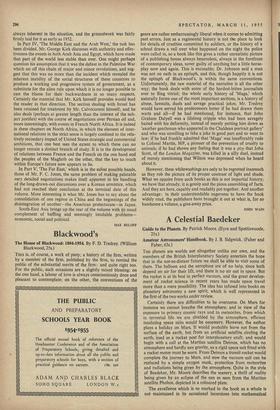A Celestial Baedeker
Tun planets are worlds not altogether unlike our own, and the members of the British Interplanetary Society entertain the hope that in the not-so-distant future we shall be able to visit some of them. The balloon and the aeroplane are of no help, since both depend on air for their lift, and there is no air out in space. But the rocket is at its best in perfect vacuum, and the great develop- ment of rocket science in recent years has made space travel more than a mere possibility. The idea has infused into books on planetary astronomy a new spirit, which is well represented in the first of the two works under review.
Certainly there are difficulties to be overcome. On Mars for instance we cannot breathe the atmosphere; and in view of the exposure to primary cosmic rays and to meteorites, from which in terrestial life we are shielded by the atmosphere, efficient insulating space suits would be necessary. However, the author plans a holiday on Mars. It would probably leave not from the surface of the earth, but from an artificial satellite circling the earth, used as a rocket post for interplanetary craft; and would begin with a call at the Martian satellite Deimos. which has no atmosphere and hardly any gravity, so a rigid space suit fitted with a rocket motor must be worn. From Deimos a transit rocket would complete the journey to Mars, and now the vacuum suit can be replaced by a simple oxygen mask, protection from meteorites and radiations being given by the atmosphere. Quite in the style of Baedeker, Mr. Moore describes the scenery, a thrill of reality being given by an eclipse of the sun as seen from the Martian satellite Phobos, depicted in a coloured plate.
The excellence which is so marked in the book as a whole is not maintained in its occasional incursions into mathematical physics and history. Thus on page 24 Mr. Moore bases planetary evolution on a law of conservation of mechanical angular momentum, which actually is not valid when the possi- bility of exchange into electromagnetic angular momentum is taken into account. And on page 23 he tells us that for the Creation, the date 4004 ac was 'adopted by the Church for many years.' As a matter of fact, so far as I know, no date for the Creation has ever been 'adopted' by any religious body. The general acceptance of 4004 BC after the seventeenth century was due to its being printed in the margin of many editions of the Authorised Version of the Bible opposite Genesis 1. But the responsibility for this seems to have rested not with any Church but with the Universities of Oxford and Cambridge!
The second of the books under review has a different character, being unconcerned with imagination and romance. It is a most complete and scholarly reference handbook, dealing with the theoretical and instrumental background to observation, together with various matters that have practical implications. The tech- nical developments that have transformed the science in the present century are described, and much material scattered through periodical literature is here made available for the first time between the covers of a book. It is very fully illustrated, and a bibliography of nearly 600 references links it with the inter- national literature.
EDMUND WHITTAKER











































 Previous page
Previous page